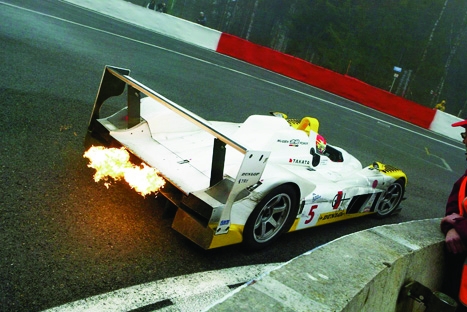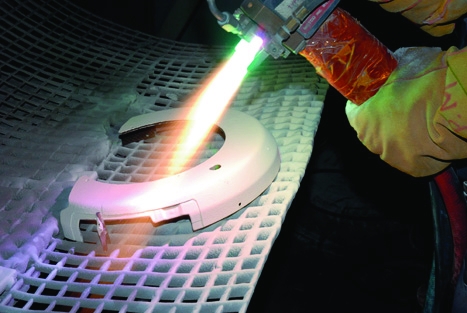
A spin out from the UK Atomic Energy Authority, Abingdon-based Zircotec has developed a process that allows a range of ceramic thermal barrier coatings to be plasma sprayed onto the surface of carbon composite, glass-fibre composite and other plastic materials.
While some of the coatings provide protection against high temperatures, others protect against corrosion, erosion and wear, which then allows the coated composites to operate in environments where they might not otherwise be suitable.
According to the firm, the process enables engineers to replace metallic components with composites; moreover, in applications where composites are already used, it can eliminate bulky heat shields that are currently made from materials such as asbestos. It can also deposit metal coatings onto the surface of the materials to enhance aesthetic appeal by providing either a complete metal finish or, more practically, it can produce a reflective coating to help protect the component from radiant heat.
The process offers the opportunity to tailor the coating to suit specific requirements, adjusting the coating properties both through thickness and across the surface of a component to cope with ’hot spots’ and differing forms of heat transfer such as radiant, conductive or convective heating.
Zircotec said the thermal coating process is so effective that it allows, for example, the composites to function at temperatures above their melting point. In testing for one application, the process gave a reduction in composite surface temperature of more than 125°C.
The deposition technique used by the company to coat any given part uses a high-temperature plasma-spraying process carried out either manually or robotically. The surface is first prepared by grit blasting or chemical etching to clean the substrate and give it a key to enhance the adherence of the coating.
Andy McCabe, technical director of Zircotec, said that the initial surface preparation techniques applied to any composite part is key to the reliability of the coating, ensuring that the bond coat will effectively bond onto the surface of the resin. Any attempt to coat directly onto a part without such pre-treating would result in very low bond strength.
’Whether we are coating a glass-based product, a carbon-fibre one, or laser-sintered nylon parts, the surface preparation techniques ensure that we can bond onto composites without causing any damage to the parts,’ he added.

The techniques the company uses, which include a range of both physical and chemical pre-treatments, are applied while ensuring that no damage is caused to the carbon or glass fibre in the composite materials, as this would weaken the structure and the properties of the parts, compromising key parameters such as fatigue.
McCabe explained that in preparing composite parts, it is important to remove the outer layer of the resin in the composite part, because often its properties differ from the resin in the bulk of the material.
’How much a composite has been heat treated also determines what methods we use to prepare the parts - some glass-fibre parts have had a very low heat treatment and may even have a range of unbound monomers in the resin - any attempt to bond onto such a material would simply result in the out gassing of the monomer when heated and the ceramic coating would not bond to it,’ he said.
After the cleaning process, a bond coat is applied using a plasma spray. The plasma-spraying process itself is a well-established technique that uses a plasma gun fed with a mixture of inert gases to create a plasma jet that emerges from its nozzle. Powder particles are then injected into the jet where they soften, after which they are accelerated towards the surface of the composite, which they strike at high velocity, whereupon molten droplets flatten, rapidly solidify and form a deposit.
In terms of the bond coats themselves, the company offers a handful of coatings that are tailored to the specific properties of each composite. At the present time, the company is unwilling to divulge any information regarding the specific nature of the bond coats it uses.
But McCabe was more forthcoming on the specific materials used for the ceramic coating itself. Zircotec offers two specific sets of coatings - one set is used where the thermal performance of the composite needs to be enhanced, the other set where the anti-wear properties need to be improved.
On the thermal barrier coating front, Zircotec can apply a mix of different ceramic materials such as zirconia, alumina and titanium oxide coatings. If anti-wear is the key consideration to be addressed, then the company takes its pick from a range of molybdenum, aluminium, stainless-steel and tungsten coatings.
The company also has the ability to build in a conductive sub-layer onto a composite that can help to dissipate heat away from any hot spots, and can also help deal with transient heating situations.
The choice of the specific coating, or mixture thereof, is dependent on how the part is going to be used, how much temperature it is required to withstand, how much wear is taking pace and whether the part is in contact with a stream of hot gas or if it needs to survive salt spray on the road.
Aside from enhancing the characteristics of any composite part, the surface of the composite can be sealed with a coloured cosmetic finish, or a metallised coating can be applied in order to reflect heat from the surface of the composite.
’As each specific application is unique, we work closely with the component developers to ascertain which coating would provide the optimal result, sharing details of the specifics of the coating and the treatment under a non-disclosure agreement,’ explained McCabe.
The company’s carbon composite coatings are now being widely used on body panels, heat shields and the rear low aerofoils of racing cars, where carbon composites can suffer from heat and erosion from exhaust gases. The company is also supplying many of the Formula 1 racing teams with parts, coating a range of composite parts for disk brake subassemblies including callipers, cooling ducts and bridges.
Despite the effectiveness of the coatings, the plasma-spray coating process itself is still only economically feasible where relatively low-volume parts need to be produced.
McCabe admits that to bring the process to the mass market would be a significant technical challenge due to the hurdles involved in cost reducing the coating process and the coating materials themselves.
Nevertheless, many potential opportunities still exist outside the automotive industry where the coating technology can be applied for lower-volume production runs of up to 500 parts.
In one such application, the company recently patented a specific means to coat lightweight carbon-composite bike rims, a process that involves applying a bond coat followed by a wear-resistant ceramic coating of titanium dioxide.
The company believes that this technique could alleviate the problems that have been experienced by performance riders using abrasive wet-weather brakes who have experienced excessive wear on existing carbon-composite rims.
production essentials
The key facts to take away from this article
- Zircotec has developed a plasma-sprayed ceramic coating process
- The process allows the coating to be tailored to suit requirements
- The coatings can enhance the characteristics of any composite part
- This process is currently only economically feasible for low volumes




Project to investigate hybrid approach to titanium manufacturing
What is this a hybrid of? Superplastic forming tends to be performed slowly as otherwise the behaviour is the hot creep that typifies hot...